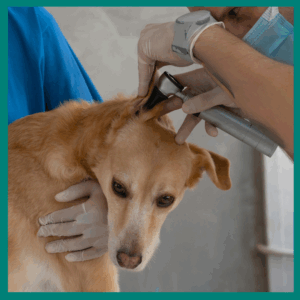Case Study: Life After Ear Surgery 
Many dogs experience the occasional ear infection, but for some, ear problems can become a constant and painful part of life. This was the case for Barney, a much-loved patient of ours, who had been suffering from recurrent ear infections for several years.
Despite regular treatments, Barney’s ears would flare up again and again, leaving him uncomfortable and his owner understandably worried. After discussions with our veterinary team, his owner decided to go ahead with a surgical procedure called a Total Ear Canal Ablation (TECA) to give him a fresh start.
What Causes Ear Disease in Dogs?
Ear disease often begins with inflammation of the skin lining the ear canal, a condition called otitis externa. If this inflammation continues, it can spread deeper into the middle ear, causing otitis media.
In many cases, ear inflammation is actually part of a wider skin condition or allergy. This is why dogs with sore ears may also lick or chew their paws, or show irritation in other areas of their skin. Some dogs even develop clear signs of skin allergy across their body alongside their ear problems.
But why are the ears often worse than the rest of the skin? The answer lies in the ear canal itself. Its warm, moist environment is the perfect breeding ground for bacteria and yeast. When allergies or irritation cause even mild inflammation, these organisms multiply rapidly, which in turn worsens the inflammation. This creates a vicious cycle — the more inflamed the ear, the more organisms grow, and the harder it becomes to break the cycle.
 What is a TECA?
What is a TECA?
A TECA is a specialist surgery that involves removing the ear canal when it has become permanently diseased. For dogs with severe, chronic ear problems, this can be the kindest option, as it removes the source of pain and infection once and for all.
Does a TECA Make a Dog Deaf?
A common question from owners is whether their dog will go deaf after surgery. Because the ear canal is removed, hearing from that ear is usually very limited or lost. However, in most cases the ear is already so badly damaged that the dog has little useful hearing left before surgery.
Dogs adapt incredibly well, even if both ears are affected. They rely on other senses such as smell and vision, and the most noticeable change is often positive — no more constant pain or irritation. Many owners tell us their dog actually seems brighter and more content afterwards.
Barney’s Journey
Because both ears were affected, Barney underwent two separate operations — one ear at a time, to allow him to recover properly in between. While the surgery is a big step, he bounced back brilliantly after each procedure.
His owner quickly noticed a change: no more head shaking, no more scratching, and most importantly, no more painful infections. After years of discomfort, Barney is able to enjoy life without sore ears.
A Happy Outcome
Since his surgeries, Barney hasn’t had a single ear problem. He’s back to his happy, lively self, and his owner has peace of mind knowing he’s no longer suffering.
Click HERE to see a video of another dog whose owner made an informative video about their dog’s TECA recovery.
TECA Surgery: Quick FAQ
What is a TECA?
A Total Ear Canal Ablation removes a chronically diseased ear canal, ending pain and repeated infections.
Will my dog go deaf?
Hearing in the affected ear is usually already very limited. Dogs adapt well and continue to enjoy life using other senses.
How long is recovery?
Most dogs bounce back comfortably within a few weeks with proper pain relief and care.
Can both ears be done?
Yes — if needed, each ear can be operated on separately to allow full recovery between surgeries.
What are the benefits?
TECA breaks the cycle of chronic ear infections, relieving pain and greatly improving quality of life.
Is it painful?
Pain is carefully managed by your veterinary team, and most dogs are noticeably more comfortable within days.

 What is a TECA?
What is a TECA?


